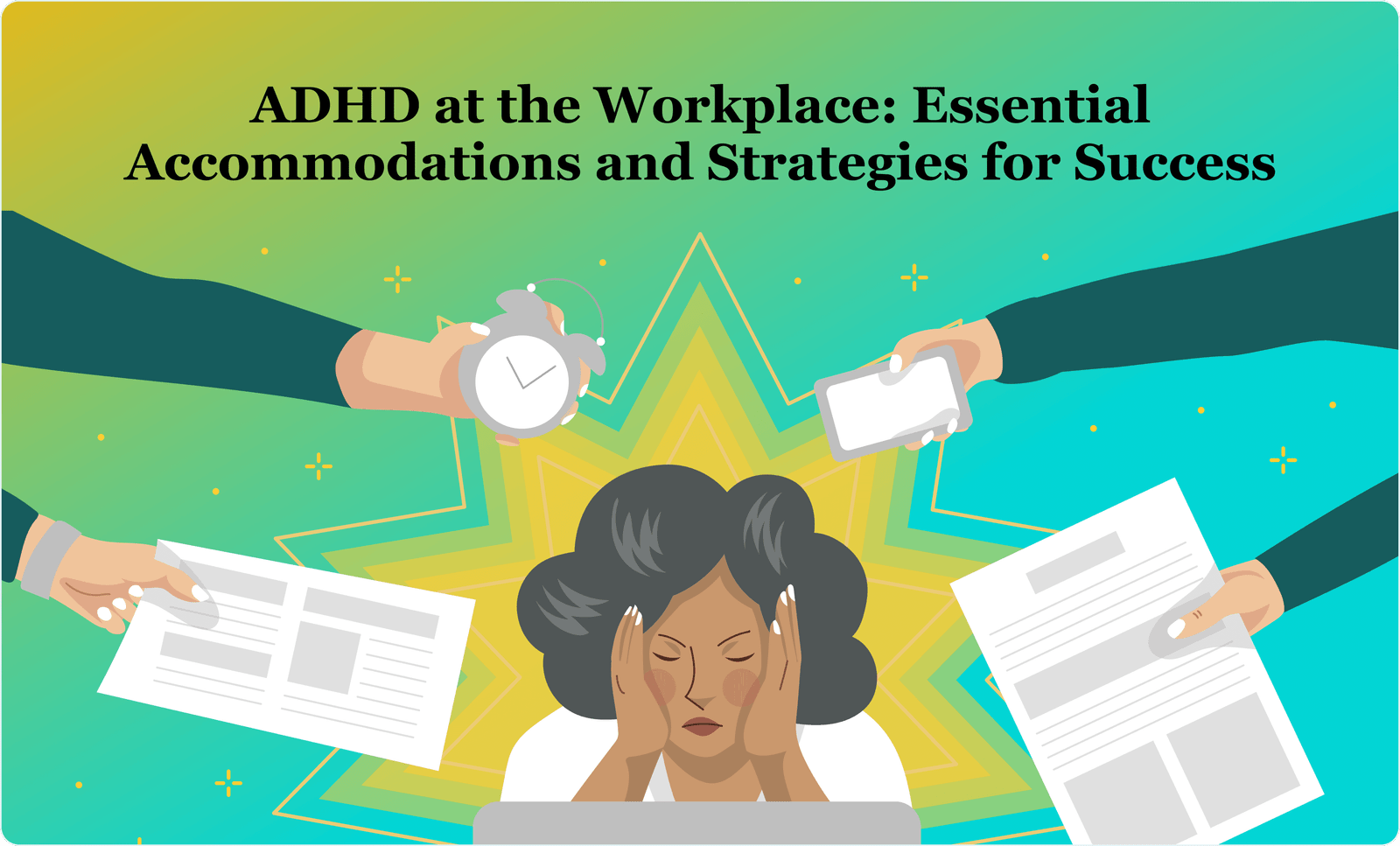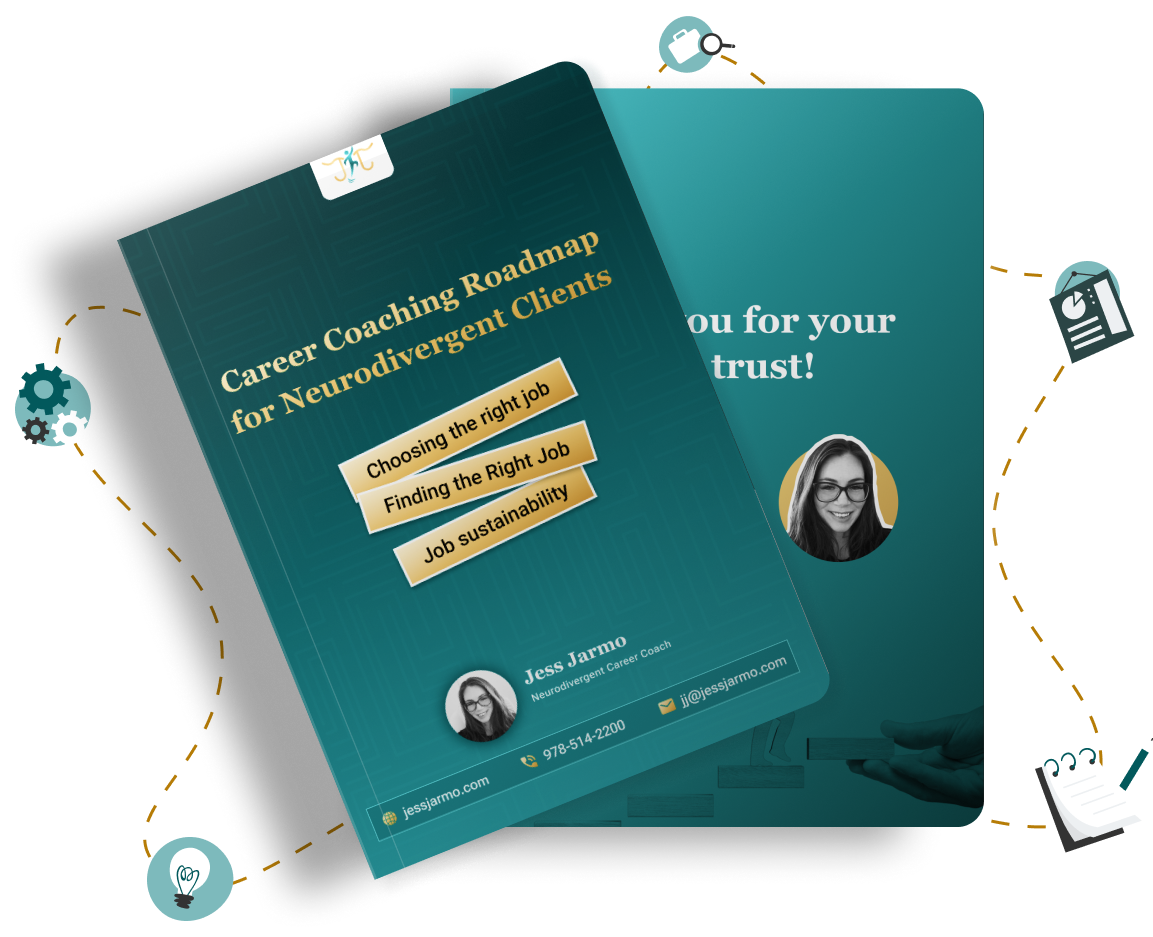

Table Of Content
Navigating the professional world can be challenging for anyone, but for individuals with Attention Deficit Hyperactivity Disorder (ADHD), the workplace can present unique hurdles. As an ADHD Career Coach, I’ve seen firsthand how tailored accommodations and strategies can transform these challenges into opportunities for success.
In this blog, we’ll explore the essential accommodations available, how they can help, and practical strategies for thriving in the workplace. We’ll also provide a guide on how to request these accommodations effectively.
Understanding ADHD and Its Impact on the Workplace
What Is ADHD?
ADHD is a neurodevelopmental disorder characterized by symptoms such as inattention, hyperactivity, and impulsivity. These symptoms can affect various aspects of an individual’s life, including their work performance and interactions. However, with the right support and strategies, people with ADHD can thrive in their careers.
How ADHD Impacts the Workplace?
ADHD can affect job performance in several ways:
- Difficulty in focusing on tasks, leading to decreased productivity.
- Challenges with time management and meeting deadlines.
- Struggles with organization and maintaining a tidy workspace.
- Impulsivity, which can affect decision-making and relationships with colleagues.
Recognizing these challenges is the first step in identifying the accommodations that can help manage them effectively.
ADHD Workplace Accommodations: What Are They and How Can They Help?
What Are Workplace Accommodations?
Workplace accommodations are adjustments or modifications provided by an employer to help employees with disabilities perform their job functions more effectively. For individuals with ADHD, accommodations can help mitigate the impact of symptoms and improve job performance.
How Can Accommodations Help?
1. Enhancing Productivity: Accommodations can help individuals focus better, manage their time effectively, and stay organized.
2. Reducing Stress: By providing tools and strategies to manage ADHD symptoms, accommodations can reduce the stress and anxiety associated with work.
3. Improving Job Satisfaction: With the right support, individuals with ADHD can feel more competent and confident in their roles, leading to increased job satisfaction and retention.
Common ADHD Workplace Accommodations
1. Flexible Work Hours
Allowing employees to start and end their workday at different times or providing options for part-time work or job sharing.
Benefits: Flexibility can help employees manage their symptoms better, reduce stress, and improve work-life balance. For example, starting work later might allow someone to avoid the stress of a morning commute and align better with their natural productivity peaks.
2. Remote Work Options
Providing the ability to work from home or another location outside the traditional office setting.
Benefits: Remote work can reduce distractions, provide a more comfortable work environment, and allow for better focus. It also allows employees to design their workspace to suit their needs, such as a quieter setting or a specific organizational setup.
3. Task Management Tools
Offering software or tools that help with task organization, time management, and prioritization.
Benefits: Tools like Trello, Asana, or even simple digital calendars can help individuals with ADHD keep track of their tasks, deadlines, and appointments, reducing the risk of missed deadlines or forgotten tasks.
Read more: Top 7 ADHD Productivity Tools for Professionals
4. Noise-Canceling Headphones
Providing headphones to block out background noise in a busy office environment.
Benefits: Noise-canceling headphones can help reduce distractions and improve concentration, especially in open-plan offices or noisy environments.
5. Regular Breaks
Allowing for short, frequent breaks throughout the day.
Benefits: Regular breaks can help individuals manage their energy levels, reduce fatigue, and maintain focus. These breaks can be used for quick physical activity, which can help in managing hyperactivity symptoms.
6. Modified Workspaces
Adjusting the physical workspace to meet the employee’s needs, such as providing a quiet area or a standing desk.
Benefits: A tailored workspace can help reduce distractions, improve comfort, and enhance productivity. For instance, a quiet corner away from high-traffic areas can minimize interruptions and allow for better concentration.
7. Coaching and Mentorship
Providing access to coaching or mentoring to help with skill development and workplace strategies.
Benefits: An ADHD Career coach or mentor can provide personalized support and guidance, helping individuals develop strategies to manage their symptoms and improve their performance at work.
8. Written Instructions and Documentation
Providing detailed written instructions for tasks and projects.
Benefits: Written instructions can help individuals with ADHD better understand and remember their tasks, reducing the likelihood of errors or missed steps.
9. Time Management Training
Offering training sessions focused on improving time management skills.
Benefits: Training can provide practical strategies for managing time more effectively, such as using timers, setting priorities, and breaking tasks into smaller, more manageable steps.
Requesting Workplace Accommodations for ADHD Individuals: A Step-by-Step Guide
1. Understand Your Rights
Under the Americans with Disabilities Act (ADA), individuals with ADHD are entitled to reasonable accommodations at work. It’s essential to understand your rights and the types of accommodations you can request.
2. Identify Your Needs
Reflect on the challenges you face at work due to your ADHD symptoms. Identify the specific accommodations that could help you manage these challenges effectively.
3. Prepare Your Request
When preparing your request, be clear and specific about the accommodations you need and how they will help you perform your job more effectively. Provide examples of how these accommodations have helped you in the past, if applicable.
4. Schedule a Meeting
Request a meeting with your supervisor or the HR department to discuss your needs. Choose a time when you can have an uninterrupted conversation.
5. Present Your Case
During the meeting, present your case clearly and confidently. Explain your ADHD diagnosis and how it affects your work, and provide a detailed explanation of the accommodations you’re requesting.
6. Provide Documentation
Be prepared to provide documentation from a healthcare professional that supports your diagnosis and the need for accommodations.
7. Follow Up
After your meeting, follow up with a written summary of what was discussed and any agreements made. This helps ensure that both you and your employer are clear on the next steps.
ADHD in the Workplace Strategies: Practical Tips for Success
1. Prioritize and Organize
Use Tools: Utilize task management tools to prioritize and organize your tasks. Break larger projects into smaller, more manageable steps and set deadlines for each step.
Create Lists: Keep to-do lists and check them off as you complete each task. This not only helps you stay organized but also gives you a sense of accomplishment.
2. Manage Time Effectively
Set Alarms: Use alarms or timers to remind you of deadlines or to take breaks. This can help you manage your time more effectively and avoid procrastination.
Schedule Tasks: Schedule specific times for tasks and stick to them. For example, dedicate the first hour of your workday to responding to emails and the next hour to working on a specific project.
3. Minimize Distractions
Create a Quiet Workspace: Find or create a workspace with minimal distractions. Use noise-canceling headphones or a white noise machine to block out background noise.
Limit Interruptions: Let colleagues know your preferred times for focusing on tasks and ask them to avoid interrupting you during these periods.
4. Develop Routines
Establish Routines: Develop daily routines to help you stay on track. For example, start your day by reviewing your to-do list and end it by preparing for the next day.
Stick to a Schedule: Try to stick to a consistent schedule for work tasks, breaks, and meals. This can help you establish a sense of order and predictability.
5. Seek Support
Build a Support Network: Connect with colleagues, mentors, or support groups who understand your challenges and can provide guidance and support.
Utilize Resources: Take advantage of resources available to you, such as employee assistance programs, ADHD support groups, or online forums.
6. Practice Self-Care
Prioritize Self-Care: Make time for self-care activities that help you manage stress and maintain your well-being. This can include exercise, meditation, or hobbies you enjoy.
Get Adequate Rest: Ensure you get enough sleep each night, as lack of sleep can exacerbate ADHD symptoms and affect your performance at work.
Supporting ADHD in the Workplace: A Collective Effort
Creating a supportive work environment for individuals with ADHD requires a collective effort from both employers and employees. Employers should strive to understand the unique challenges faced by individuals with ADHD and provide the necessary accommodations and support. Employees, on the other hand, should take proactive steps to manage their symptoms and seek out the resources and accommodations they need.
By fostering a workplace culture that values diversity and inclusivity, we can help individuals with ADHD reach their full potential and contribute to a more productive and innovative workforce.

